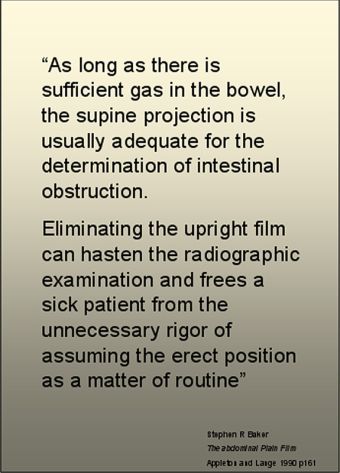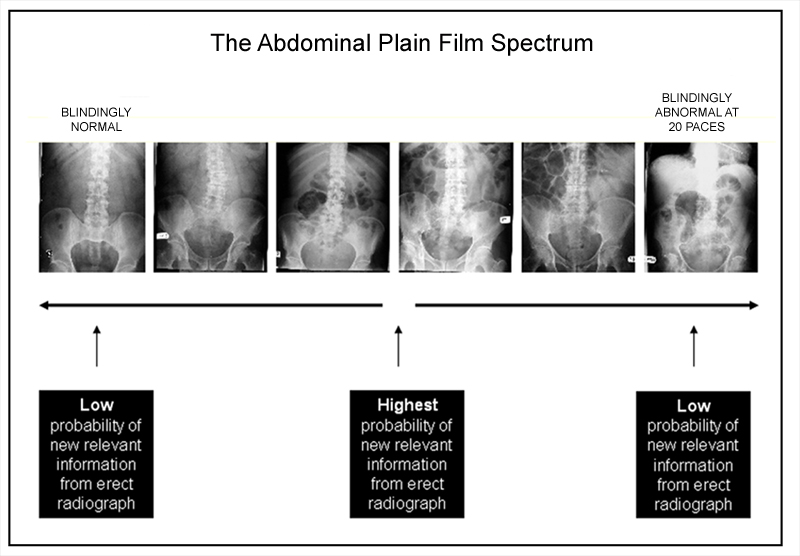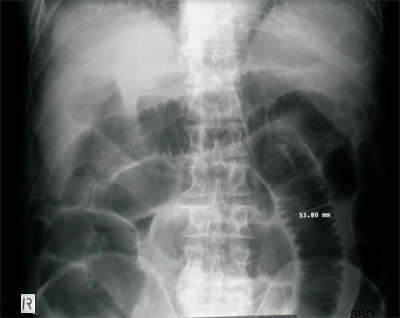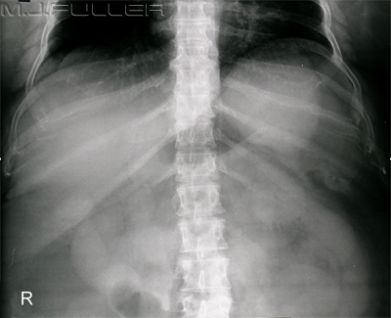The Erect Abdominal Plain Film
This page is presented in the context of imaging services provided to an Emergency Department. Some of the content may not apply in a different context.
The abdominal plain film examination is possibly the least understood procedure in medical imaging. The confusion regarding the role of the supine abdominal plain film is surpassed only by the erect abdominal plain film.
I strongly suspect that over a working lifetime as a radiographer I have commonly performed erect abdominal plain films on patients when it was not indicated and not performed one when it was indicated. This page considers why this happens.
What is the Role of the Erect Abdominal Plain film in the ED?
The difference between the supine abdominal plain film and the erect abdominal plain film has plenty to do with gravity and not much else. Not to put too fine a point on it, the AP supine abdominal plain film and the erect AP abdominal plain film are the same projections of the same anatomy under the same gravitational forces. The difference lies in the fact that a contained air/fluid filled structure will have an interface that is imaged en face in the supine projection and in profile in the erect projection.
There are, of course, other more subtle benefits of the erect plain film as follows
- potential to include all of the upper abdomen (centre slightly more superiorly)
- in a gasless obstruction, loops of fluid filled small bowel can be seen to drop under the effect of gravity
- others I'm sure
The Thermometer Analogy
The Poster
|  |
The Abdominal Plain Film Spectrum
Abdominal plain films are not necessarily either normal or abnormal; this is not a dichotomy- it's a continuum. If you are one of those people that like to categorise things, you could think of them as being;
normal -------------> probably normal ----------> suspect ------->probably abnormal-----> definitely abnormal
Example Cases
Erect Abdominal Plain Film Protocol Options
The left image (case1) demonstrates small bowel loops (probably ileum and jejunum) to be dilated with air to 53mm. The dilated jejunal loops have a pattern known as coiled spring sign. I emphasise that you have now diagnosed that the small bowel is abnormally dilated and it contains large volumes of air. How important is it to also establish whether the small bowel also contains fluid? Will this information assist in confirming the diagnosis? The answer of course is no- whether the small bowel contains fluid as well as air is, under normal circumstances, highly irrelevant.
Consider the image on the right (case 2). You might notice that this patient appears to have gastrografin in their small bowel. This is not correct. The patient has fluid-filled small bowel and this is suggestive of a gasless small bowel obstruction... but you want to be sure. A person who has recently overeaten might have a similar appearance. I would definitely perform an erect abdominal film in the hope of demonstrating a string of pearls sign.
To summarise, both patients are likely to have a small bowel obstruction. The difference is that one patient has a firm diagnosis on the supine image and the other has a strong suggestion. Which patient would you have chosen to perform an erect abdominal film on?
Recommendations of the Radiology Professional OrganisationsOption1Every patient who presents with an acute abdomen in the ED has a 3 view acute abdominal series (S, E, CXR)
Option2
No patients who present with acute abdominal pain have an erect abdominal film- supine only
Option 3Option 4Suitable patients who present with acute abdominal pain/symptoms have a supine abdominal film. An erect abdominal film is performed (after viewing the supine abdominal film) only if it is likely to provide additional relevant information and/or added confidence to the diagnosis
Low dose CT on all acute abdomen patients
I suspect that all of these protocol options are variously adopted in different centres. My preference is for option 3, that is, perform erect abdominal radiography to clarify any appearances on the supine film or, on balance, where there is a reasonable chance of new relevant information.
The concepts discussed above are supported by most Radiology professional bodies. The Australian, North American and United Kingdom Radiologist's professional organisations all make similar recommendations
"The erect film is to be used in 'equivocal circumstances',
i.e. where the supine film is either not conclusive or open to variable interpretation”
Royal College of Radiology Guidelines
The following quote provides an insight into what it is like to look at the abdominal plain film from another perspective
“… the surgical registrars felt that the X-ray had helped
in their management of half the patients,
probably because the majority of the radiographs either confirmed
or at least did not refute their clinical suspicions”
Stower, M.J. et alEvaluation of the Plain Abdominal X-ray in the Acute AbdomenJournal of the Royal Society of Medicine, Volume 78, August 1985 p 632
.
The erect abdominal plain film is often utilised when it could reasonably be expected to provide no new diagnostic information. When you are asked to perform an erect abdominal plain film, and you consider it unnecessary, it would be prudent to adopt a philosophy of a joint education exercise. The suggested attitude for radiographers is
- emphasis should be on education not confrontation
- adopt the attitude of a joint learning exercise
- mutual support
- you might be wrong



